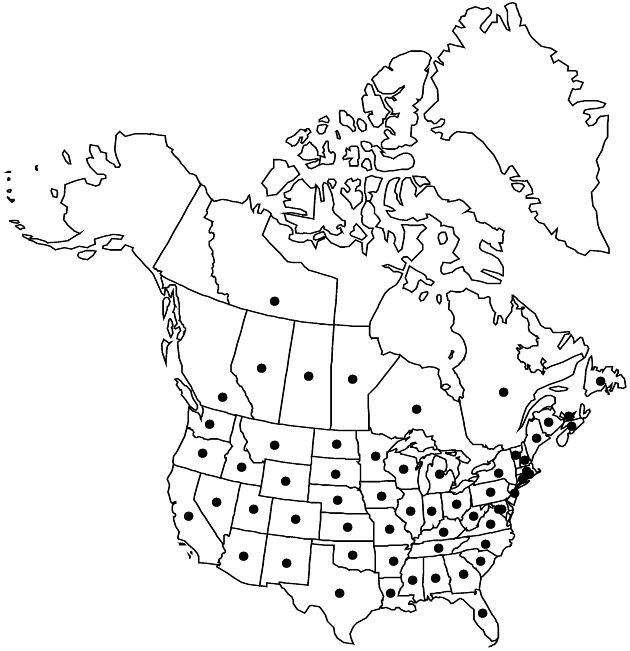Symphyotrichum lanceolatum
Phytologia 77: 284. 1995.
Perennials, 30–150 (–200) cm, colonial; long-rhizomatous (rhizomes usually white, thick, contorted). Stems 1, erect (straight, stout), glabrous or hairy. Leaves thin, scabrous, apices mucronate, abaxial faces glabrous (vein areoles indistinct, elongate), adaxial glabrous or sparsely scabrous (var. hesperium); basal withering by flowering, petiolate to subpetiolate (petioles winged, ciliate, bases dilated, sheathing), blades elliptic-oblanceolate or obovate to suborbiculate, 10–80 × 5–20 mm, cuneate to attenuate, margins crenate-serrate, apices acute to obtuse or rounded; proximal cauline withering by flowering, sessile or subsessile, blades lanceovate or oblanceolate to linear-lanceolate, (40–) 50–150 × (3–) 10–20 (–35) mm, progressively reduced distally, bases cuneate, ± decurrent, margins serrate, apices acute to acuminate; distal sessile, blades oblanceolate to linear, 30–100 (–140) mm, only slightly reduced distally, bases cuneate, margins entire. Heads in ample or diffuse to narrow, elongate, leafy, paniculiform arrays, branches ± ascending, rarely secund, branch leaves often longer than pedicels. Peduncles 0.5–5 cm, ± pilose, bracts 1–3 (–5), linear-oblanceolate to lanceolate, foliaceous, ciliate. Involucres campanulate to cylindric, 3–8 mm. Phyllaries in (3–) 4–6 series, appressed or slightly spreading, linear-lanceolate to linear (innermost), sometimes slightly dilated distally, ± strongly unequal to subequal (var. hesperium), bases indurate 1/4–1/2, margins scarious, erose, hyaline, sparsely ciliolate, green zones lanceolate to linear-lanceolate, outer sometimes foliaceous (particularly var. hesperium), apices acute to acuminate (outer) or acuminate to caudate (inner), mostly mucronulate, abaxial faces glabrous, adaxial sparsely strigillose. Ray-florets 16–50; corollas white to pinkish or pale blue-violet, laminae 3–10 (–14) × 0.5–1.3 mm. Disc-florets (13–) 20–40 (–52); corollas yellow becoming purple, 2.8–5.8 mm, tubes shorter than funnelform throats, lobes sometimes ± spreading, triangular, 0.4–1.2 mm. Cypselae gray or tan, obovoid, ± compressed, 1.5–2 mm, 4–5-nerved, faces sparsely strigillose; pappi white to sordid or tawny, 5.5–6 mm.
Distribution

Alta., B.C., Man., N.B., N.S., N.W.T., Nfld. and Labr. (Nfld.), Ont., P.E.I., Que., Sask., Ala., Ariz., Ark., Calif., Colo., Conn., D.C., Fla., Ga., Idaho, Ill., Ind., Iowa, Kans., Ky., La., Maine, Mass., Md., Mich., Minn., Miss., Mo., Mont., N.C., N.Dak., N.H., N.J., N.Mex., N.Y., Nebr., Nev., Ohio, Okla., Oreg., Pa., R.I., S.C., S.Dak., Tenn., Tex., Utah, Va., Vt., W.Va., Wash., Wis., Wyo., in Europe
Discussion
Varieties 5 (5 in the flora).
Varieties of Symphyotrichum lanceolatum are sometimes grouped into two subspecies: subsp. hesperium (var. hesperium) and subsp. lanceolatum (the other four varieties). J. C. Semple and J. G. Chmielewski (1987) provided maps of the five taxa. The ranges of var. hesperium and var. lanceolatum overlap in the prairies and in the boreal zone from Alberta to the Clay Belt of northern Ontario. The ranges of the other three varieties do not overlap with that of var. hesperium, but they all overlap each other and with var. lanceolatum in the Midwest. The ecology and cytogeography of the species were summarized by Chmielewski and Semple (2001). The name Aster tradescantii has sometimes been misapplied to this species.
Lower Taxa
Key
| 1 | Outer phyllaries 2/3 + length of inner ones; heads usually subtended by large foliaceous bracts; cordilleras and prairies (subsp. hesperium) | Symphyotrichum lanceolatum var. hesperium |
| 1 | Outer phyllaries 1/3 – 2/3 length of inner ones; heads not usually subtended by large foliaceous bracts; prairies eastwards (subsp. lanceolatum) | > 2 |
| 2 | Stems stout, moderately to densely short-woolly from bases; Great Lakes region to se Manitoba | Symphyotrichum lanceolatum var. hirsuticaule |
| 2 | Stems stout to slender, glabrous or at most hairy in lines at bases | > 3 |
| 3 | Heads congested on lateral branches of arrays; involucres 3–4 mm; midwestern United States, s Ontario, s Quebec | Symphyotrichum lanceolatum var. interior |
| 3 | Heads not congested or congested only distally on lateral branches of arrays; involucres 3.6–5.6 mm (mostly longer than 4 mm) | > 4 |
| 4 | Leaves broadly oblanceolate, not much reduced in arrays; involucres usually 4–5.5 mm; rays white | Symphyotrichum lanceolatum var. latifolium |
| 4 | Leaves linear to oblanceolate, reduced in arrays; involucres 3.5–5(–6) mm; rays white to purplish | Symphyotrichum lanceolatum var. lanceolatum |
"thin" is not a number.